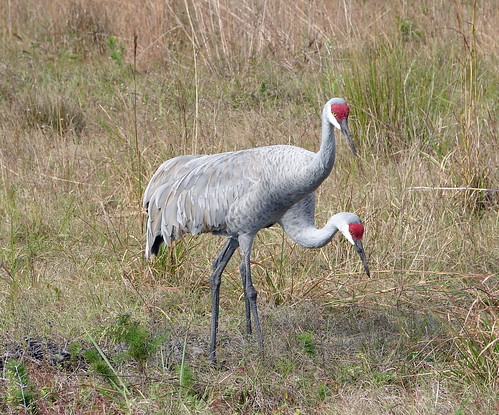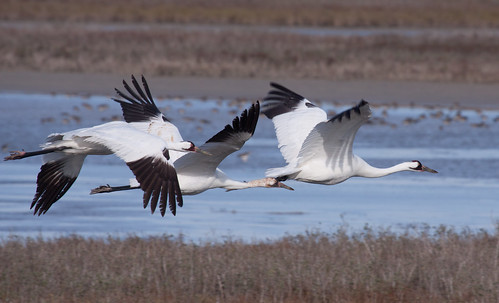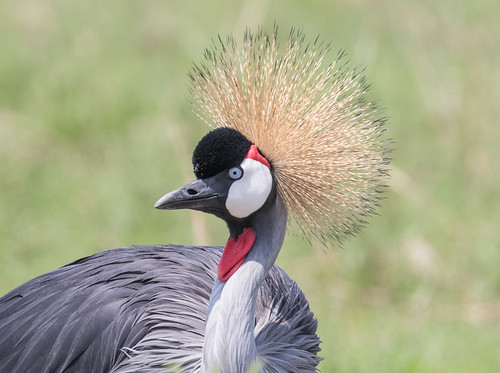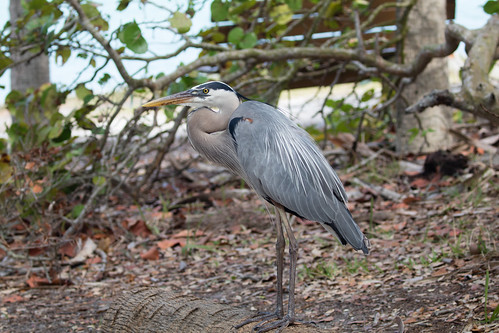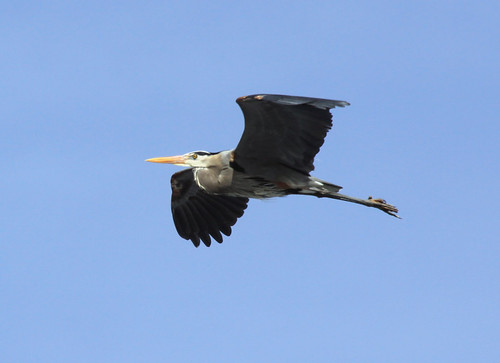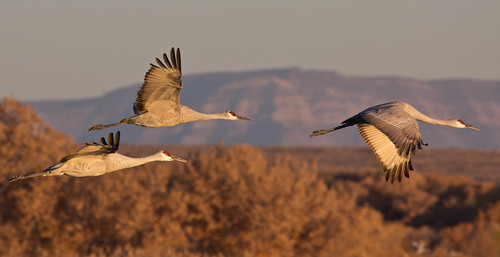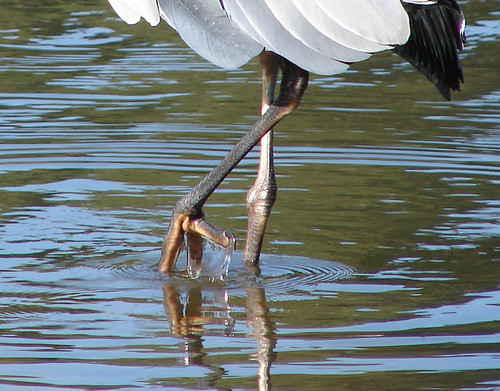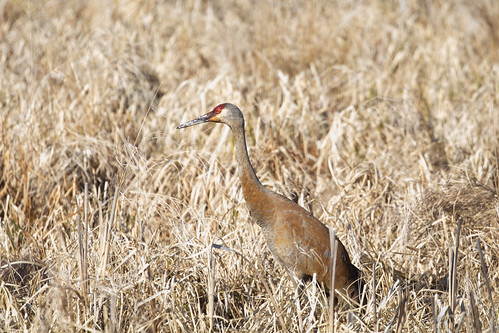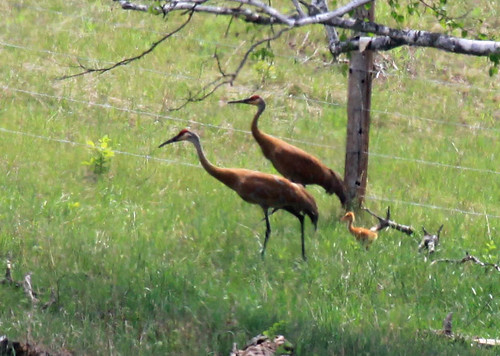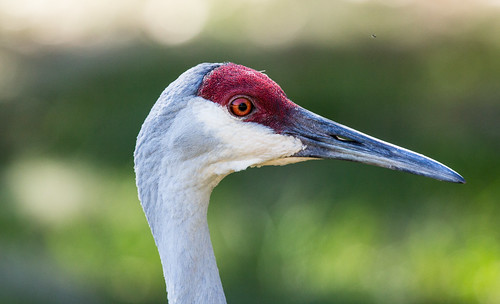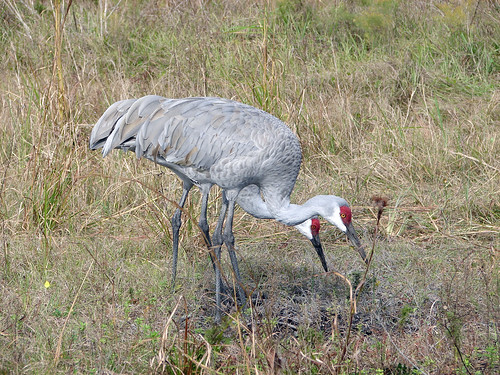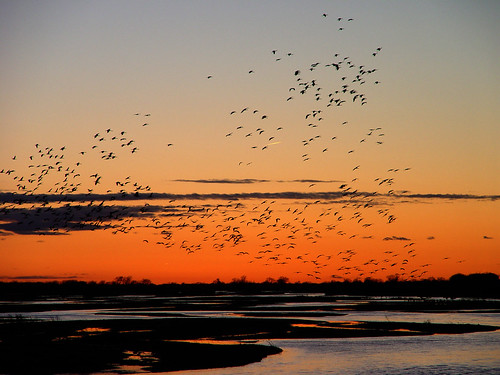I’m going to be highlighting some special birds during these dark times. Thanks to Anne’s webinar, I’ve decided to make the Sandhill Crane the first in this series.
In all the world, there are 15 species of cranes, found on every continent except Antarctica and South America. Some are rare and localized, others more widespread. Two species breed in North America: the endangered Whooping Crane and the much more abundant Sandhill Crane. Common Cranes, which breed in northern Europe and Asia, wander fairly regularly to North America, most often mingling with Sandhill Cranes during migration and winter.
One Demoiselle Crane, a species which belongs primarily in Asia and the Middle East and has a rigorous migration over the Himalayas, was documented in October 2001 in San Joaquin County, California. Another, or perhaps the same individual, was photographed in Alaska the following May. And one Hooded Crane, which belongs in Japan, Korea, and China, was reported and photographed mingling with Sandhill Cranes in April 2011 in Nebraska, that December in Tennessee, and in February 2012 in Indiana. Again, this may have been a single wayward individual.
I've seen almost all of the crane species in the world, alive but not in the wild, at the International Crane Foundation, whose co-founder, Ron Sauey, was a good friend of mine. He died tragically over 30 years ago now. I've seen only three species of cranes in the wild—our own Whooping and Sandhill Cranes, and the Gray Crowned-Crane in Uganda.
The word crane is from Middle English cran, akin to Old High German krano, and was first used before the 12th century. Cranes are featured in mythology and art of many cultures, so people almost certainly came up with words for these birds very early in human language development. The Sandhill Crane was named for the rolling hills of sand characteristic of parts of its range in the Middle West and Southeast, where the birds were first seen by early ornithologists. Linnaeus gave it the scientific name Grus canadensis in 1758; grus is Latin for crane. But DNA research published in 2010 established that the Sandhill Crane, the White-naped Crane of temperate East Asia, the Brolga of Australia, and the Sarus Crane of India and Southeast Asia belong to an entirely separate clade from other members of Grus. The American Ornithologists placed those four species in a brand-new genus, Antigone, in 2016. So now the Sandhill Crane is Antigone canadensis.
Intriguingly, one population of Sandhill Cranes breeds in northeastern Siberia, crossing back to North America to winter in the Southwest. Common Cranes also breed in that part of Siberia, and the two species occasionally hybridize even though they’re not closely related. Without access to, or indeed any interest in, 23AndMe or ancestry.com, cranes fall in love as they please. That scientifically judged “inappropriate” breeding may have been a factor in scientists choosing the Sandhill Crane’s new genus name—in Greek mythology, Antigone is the name of Oedipus’s daughter/half-sister.
Besides the population of Sandhill Cranes that crosses into Siberia to breed, there are some extraordinary, now regular and increasing, records of Sandhill Cranes spending the non-breeding season in China, South Korea, and Japan. It’s possible that the wayward Hooded Crane mentioned above started associating with Sandhills from this odd wandering group and followed them back to America.
Nonmigratory populations of Sandhills, each belonging to its own subspecies, live year-round in Cuba, Florida, and near the Gulf Coast in Mississippi. The Cuba and Mississippi populations are rare and endangered.
Sandhill Cranes have been recorded flying as high as 13,000 feet as they migrate through the Rocky Mountains. Even over the very flat Platte River area in Nebraska, they can rise extremely high on thermal air currents during their migration. Demoiselle Cranes have been seen flying over Mount Everest, at about 28,000 feet above sea level. When I’ve been in Nebraska in March watching departing flocks circling on thermals, rising higher and higher until even through 10-power binoculars they look like the tiniest pepper specks in the sky and then disappear altogether, I’ve often wondered how high they were.
Sandhill Cranes are hefty birds, averaging about 4 feet from tip of beak to tip of tail, about the same length as Great Blue Herons.
Sandhill Cranes have an average wingspan of 6 ½ feet; Great Blues of 6 feet. The crane’s wider wingspan is necessary to support its heavier body—depending on sex and subspecies, Sandhill Cranes weigh between almost 7 pounds and 14 pounds. In comparison, the heaviest Great Blue Herons weigh only about 5 pounds!
How the weight is distributed in a crane’s body compared to a heron’s explains the two species' different flying postures. Sandhill Cranes pick at a wide variety of slow-moving food items, including tubers, fruits, and seeds but also sluggish frogs, large insects, and other invertebrates. Their bill is substantial but needs nowhere near the structural heftiness that herons require to slam their bill into thick-bodied, stiff fish. And because crane food doesn’t move fast, they don’t need the kinds of thick neck muscles that give herons those lightning fast reflexes.
When a heron’s heavy neck and bill are outstretched, much of its weight is forward of its scrawny body. To stay aloft without stalling, herons must pull their head way in to put their center of gravity where it belongs for successful flight.
Cranes have much heavier bodies, and their necks and bills are lighter both absolutely and relatively compared to herons, so they easily fly with their necks outstretched.
Both cranes and herons typically fly with their legs trailing behind them, but in March 1996, when I was visiting Nebraska when temperatures were well below zero, most of the flying cranes pulled their feet close to their bodies, something I’ve never seen before or since. (That was before I was photographing birds.)
Cranes and herons are different in another important way. Both have four toes—three in front and one behind. But the hind toe on herons is long and strong, allowing them to grasp branches and to nest in trees.
 |
| I took this photo of a Sandhill Crane foot in the Rowe Audubon Sanctuary. Live cranes do not approve of showing off their feet like this. |
That’s because when they preen, they often smear mud into their feathers, staining them with iron oxide. Researchers have found that captive cranes also stain their feathers, and birds sometimes gather to preen where soils are especially iron-rich. The Common Crane is the only other species in the family that shares this interesting habit. Cranes with this staining are much harder to see both while on the nest and during the flightless period while they raise their chicks. Crane chicks bear rusty-colored down feathers when they hatch, giving them that cryptic coloring automatically.
The bold red of the forehead and forward part of the crown is not a plumage color, but is simply bare, bumpy (papillose) skin. Blood rushing to the area intensifies the color during aggressive or sexual displays.
Sandhill Cranes nesting in the northern extreme of their range belong to the subspecies called the “Lesser Sandhill Crane.” They average the smallest, which is opposite what Bergmann’s rule predicts—that the colder the climate, the larger a warm-blooded animal should be, which is true of ravens compared to crows and moose compared to deer. But the size differential in Sandhill Cranes is consistent with the diminutive Ross’s and Cackling Geese of the far north compared to Snow and Canada Geese. Migratory birds at the northern extremes of their ranges have a very short breeding season. Chicks of smaller species can reach full size more quickly, allowing them to migrate with their parents before frigid weather sets in for the year.
Sandhill Cranes underwent dramatic population declines throughout North America during much of the twentieth century, primarily due to habitat loss and development and over-hunting. Fortunately, this species is a generalist; after they were given protection by the Migratory Bird Treaty Act, and then after wetlands started getting more protection with the environmental laws passed in the 1970s, populations of the migratory subspecies started expanding.
Sandhill Cranes were given nongame protection in most states for decades, but now are hunted in at least 16 states. The Minnesota DNR’s nongame wildlife program used to use the Sandhill Crane as an enticement to solicit contributions. When the DNR made the crane a game species in 2010, after making another popular nongame bird, the Mourning Dove, a game species in 2004, they alienated a great many Minnesotans who had generously donated to support nongame wildlife for decades. Indeed, the Sandhill Crane remained the “poster child” for the Northwestern Region’s Nongame Wildlife Program webpage, a large photo of the crane conspicuously serving as the symbol of NONGAME wildlife for years after the DNR opened a hunting season on it in that very region of the state in 2010.
 |
| This screen capture was taken in November 2017, a full seven years after the crane was made a game species!! |
Cranes and other waterfowl are extremely vulnerable to exposure to pesticides, oil and biotoxins, and ingesting lead, plastic, and other objects. But beside habitat loss, their biggest danger from humans is collisions with manmade structures, especially power lines and the guy wires supporting communications towers near crane habitat. Wires are straight-line structures with none of the natural cues birds use to detect and gauge their distance from natural obstructions, like tree branches, in their airspace.
The power lines running along the Platte River in Nebraska have long been known to kill Sandhill Cranes. The Rowe Sanctuary worked with the local power company to retrofit one set of power lines with devices to help the cranes notice the wires. These devices are extremely cheap, and both inexpensive and easy to install when power lines are first constructed; retrofitting is much more expensive, so you’d think power companies would install them as a matter of course whenever putting up new lines, but you would be wrong.
The “bird flight diverters” being put up when I was at the Rowe Sanctuary are nothing more than simple little spirals of wire, but they add a three-dimensional element to those straight line wires, helping birds to notice and gauge their distance from the wires.
Another device, the “Firefly Bird Diverter” (which I don't have a photo of) is a more sophisticated model, consisting of a 3 1/2 by 6-inch heavy-duty plastic card with a special reflective coating that is highly visible to birds. The card hangs from a swivel attached by a clamp to the power line, rotating in winds as light as three to five miles per hour, alerting birds to the obstruction. The coating glows at night for up to ten hours, so it can help prevent nocturnal collisions as well. Sadly, even with either kind of diverter in place, there can be collisions, especially during foggy conditions.
I happened to be visiting the sanctuary in March 1996, which was an exceptionally cold month in Nebraska. Big ice floes on the Platte River made it difficult for the tens of thousands of Sandhill Cranes staging there to alight on the river in the evening. Many didn’t find their way down until well after dark, and even after birds did make it down to roost, floating ice kept coming along, flushing them throughout the night. I was there the morning seventeen cranes were picked up dead under power lines. Only one was found under a power line bearing bird flight diverters; all the rest were killed by unmarked wires.
The tens of thousands of cranes we see migrating through Nebraska virtually all belong to populations that breed in the western US and up along the west coast, some crossing to Siberia—those birds virtually never breed in Wisconsin or eastern Minnesota. "Our" cranes winter in the Southeast down to Florida, often stopping en route in Indiana. Some seem to be spending milder winters all the way up in southern Wisconsin now.
Cranes take a while to grow sexually mature. In the Mid-Continent Population, only 20 percent of 4-year-old cranes are likely to be paired, but 90 percent of 7-year-olds are paired. Regardless of age, cranes dance on and off year-round; dancing sometimes spreads throughout a whole flock as if they were in a flash mob or a Dr. Pepper commercial. Pairs form during the winter when huge numbers of cranes are mingling together, and once an attachment is formed, the birds stay together as they migrate north.
By spring, surging hormones set pairs' toes a 'tapping and wings a 'flapping more and more. The more a pair dances, the more they perfect their synchrony, which also helps them synchronize their bodies so the female will be ready to ovulate her two eggs right when the male is producing maximum amounts of sperm.
The exuberance of crane dances surges as they get closer and closer to their nesting area, and starts culminating in sex. Inexperience may make their first nestings unsuccessful, and crane pairs occasionally "divorce" after losing eggs or chicks, but with age and experience, each pair's success grows.
Both parents develop a brood patch on each side of their sternum, ideal for incubating the normal clutch of two eggs, laid 2 days apart. Both parents divide incubation duties equally during daylight hours, but the female incubates by night as her larger mate guards her. Cranes grow increasingly attentive to their nest and chicks as they themselves mature.
It takes a full month for the eggs to hatch, normally a day apart. Within 8 hours or so of hatching, a "colt" can both walk and swim. If nothing disturbs the parents, they'll keep incubating the remaining egg and caring for the colt near the nest, but predators or human disturbance may make them flee before the second egg hatches.
The female hunkers on the ground to brood the chicks, which sometimes climb on her warm back between her wings and sometimes huddle under her wings. Brooding is fairly constant in cold conditions when the chicks are tiny, but by the time they're three weeks old, they receive very little brooding.
Although the family remains fairly close together, each parent usually stays with one chick. They begin eating when about a day old. The parents feed them bill-to-bill for 10 days or so, but after that the parents are more likely to set the food on the ground, sometimes breaking larger prey into more manageable pieces. The young are capable of getting their own food by the time they're about half grown, but even after that they occasionally beg for food, and sometimes the parents offer food without even being asked. Chicks take their first flights when about 7 weeks old, and are soon strong fliers. But the family remains together through fall migration and the entire winter. It's only around the parents' anniversary that they break away for some alone time. The following fall, when they again associate with other cranes, parents may or may not recognize their young from previous years.
Cranes figure in the art and mythology of many cultures. Their graceful lines and elegant plumage figure especially prominently in Japanese art. One of the especially appealing aspects of cranes, which looms large in how they are depicted culturally, is their lifelong fidelity to their mate. We humans have a tendency to embellish some avian qualities to force them into narrow, anthropocentric and anthropomorphic storylines, but after a pair has successfully raised a chick, their fidelity is not exaggerated.
And befitting their use as a symbol of longevity, cranes really are long-lived. One Siberian Crane, related to our Whooping Crane, lived in the National Zoo in Washington, D.C., for almost 62 years. In the wild, banded Sandhill Cranes have lived over 37 years.
It's not only artists and storytellers who love cranes. Their beauty suffuses the thoughts and writings of even the most objective scientists. Aldo Leopold wrote in his exquisite A Sand County Almanac:
Our appreciation for the crane grows with the slow unraveling of earthly history. His tribe, we now know, stems out of the remote Eocene. The other members of the fauna in which he originated are long since entombed within the hills. When we hear his call, we hear no mere bird. We hear the trumpet in the orchestra of evolution. He is the symbol of our untamable past, of that incredible sweep of millennia which underlies and conditions the daily affairs of birds and men.Leopold’s essay about the crane, titled “Marshland Elegy,” is about how cranes were disappearing before his very eyes. He concludes:
To build a road is so much simpler than to think of what the country really needs. A roadless marsh is seemingly as worthless to the alphabetical conservationist as an undrained one was to the empire-builders. Solitude, was one natural resource still undowered of alphabets, is so far recognized as valuable only by ornithologists and cranes. Thus, does history, whether of marsh or marketplace, end in paradox. The ultimate value in these marshes is wildness, and the crane is wildness incarnate. But all conservation of wildness is self-defeating, for to cherish we must see and fondle, and when enough have seen and fondled, there is no wilderness left to cherish. Someday, perhaps in the very process of our benefactions, perhaps in the fullness of geological time, the last crane will trumpet his farewell and spiral skyward from the great marsh. High out of the clouds will fall the sound of hunting horns, the baying of the phantom pack, the tinkle of little bells, and then a silence never to be broken, unless perchance in some far pasture of the Milky Way.Despite the many dangers looming for Sandhill Cranes, their numbers are far, far larger than when Leopold died in 1948, two decades before the Clean Air Act, Clean Water Act, and Endangered Species Act became the law of the land. I wonder if he ever imagined that his words would themselves become a trumpet call to people all over America, sounding a plea to slow down the so-called progress that had led to Los Angeles skies being choked with smog; the Cuyahoga River literally ablaze with toxic, volatile chemicals; Bald Eagles and Peregrine Falcons merely a memory over most of their former range; and a new wonder chemical, DDT, being sprayed over wetlands and residential streets?
Leopold couldn’t have predicted that his beloved Sandhill Cranes would now be thriving, but neither could he have predicted that the moment those landmark laws came into being, forces were already consolidating to eviscerate their enforcement. Most Sandhill Crane populations are doing well right now, in large part thanks to the historical way the US Fish and Wildlife Service enforced the Migratory Bird Treaty Act, penalizing companies that inadvertently kill birds during their operations. The current administration decided to no longer investigate or fine companies that kill cranes colliding with unmarked power lines or being poisoned at oil waste pits, taking away the only financial incentive companies have to avoid killing them.
The cranes of course don't understand any of this. They'll keep on keeping on as long as they can, filling the hearts of those of us who know them with a joy that could never, ever be measured in money. It's a scurvy villain indeed who could sell off the well-being of these magnificent birds for a few dollars more.
